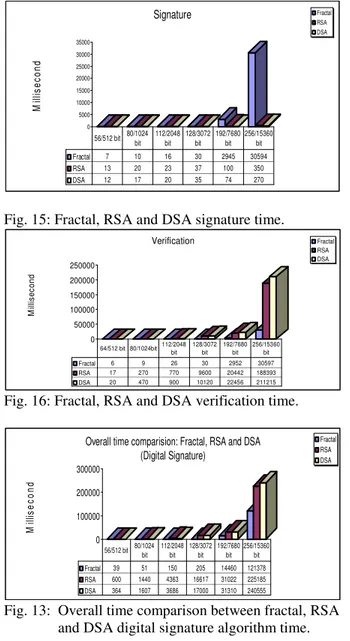ISSN 1546-9239
© 2007 Science Publications
Corresponding Author: Azman Bin Samsudin, School of Computer Sciences, University Sains Malaysia (USM), 11800, Penang, Malaysia, Tel: +604-6533888, Fax: +604-6573335
A New Digital Signature Scheme Based on Mandelbrot and Julia Fractal Sets
Mohammad Ahmad Alia and Azman Bin Samsudin
School of Computer Sciences, Universiti Sains Malaysia, 11800 Penang, Malaysia
Abstract: This paper describes a new cryptographic digital signature scheme based on Mandelbrot and Julia fractal sets. Having fractal based digital signature scheme is possible due to the strong connection between the Mandelbrot and Julia fractal sets. The link between the two fractal sets used for the conversion of the private key to the public key. Mandelbrot fractal function takes the chosen private key as the input parameter and generates the corresponding public-key. Julia fractal function then used to sign the message with receiver's public key and verify the received message based on the receiver's private key. The propose scheme was resistant against attacks, utilizes small key size and performs comparatively faster than the existing DSA, RSA digital signature scheme. Fractal digital signature scheme was an attractive alternative to the traditional number theory digital signature scheme.
Keywords: Fractals Cryptography, Digital Signature Scheme, Mandelbrot Fractal Set, and Julia Fractal Set
INTRODUCTION
Cryptography is the science of information security. Cryptographic system in turn, is grouped according to the type of the key system: symmetric (secret-key) algorithms which utilizes the same key (see Fig. 1) for both encryption and decryption process, and asymmetric (public-key) algorithms which uses different, but mathematically connected, keys for encryption and decryption (see Fig. 2). In general, cryptography protocol employs public-key algorithm to exchange the secret key and then uses faster symmetric algorithms to ensure secrecy of the data stream [1, 2].
Public-key scheme is based on the idea that a user can possess two keys, one key is known to the public and the other is private to the owner. The public-key algorithm uses the public key to encrypt the data to be sent, and then at the recipient side, uses the private key to decrypt the ciphered data. Digital signature is a verification mechanism based on the public-key scheme that is focusing on message authenticity. The output of the signature process is called the digital signature [2]. Digital signatures are then used to provide authentication of the associated input, which is called a message [3, 4] (see Fig. 3). In digital signature public-key algorithms, the private key is used to sign a message, while the public key is used to verify the authenticity of the message.
Fig. 1: Secret-key scheme.
Fig. 2: Public-key scheme.
Digital signatures scheme used to provide the following
[4]
:
• Data integrity (the assurance that data has not been changed by unauthorized party).
• Non-repudiation (the assurance that an entity cannot deny commitments).
In 1976, The first notion of a digital signature scheme was given by Whitfield Diffie and Martin Hellman, although at that time they only conjectured the existence of such scheme [5, 6]. Soon after that, in 1978, Rivest, Shamir, and Adleman invented the first digital signature scheme which is called RSA digital signature algorithm [7]. Subsequently, there are a few more proposed digital signature algorithms such as ElGamal signature scheme [8], Undeniable signature [9] and others.
Fig. 3: Digital signature scheme.
This paper proposes a new fractal (based on Mandelbrot and Julia fractal sets) digital signature scheme as a secured method to sign and verify the corresponding message. The working of the proposed scheme depends on the strong connection between the Mandelbrot and Julia sets [10] by using their special functions, Mandelfn and Juliafn functions [11], which generate the corresponding private and the public keys.
Fractals: A complex number is a number of the form a + bi, where a and b are real numbers, and i is the imaginary unit defined as i2=-1 [12]. The real number, a, is considered as the real component, and the unit i and b
are considered as the imaginary component of the complex number. The sum and product of two complex numbers are formulated as shown by Equations 1 and Equation 2.
.
1
i
c
d,
b,
a,
d)i;
(b
c)
(a
di)
(c
bi)
(a
2−
=
∈
+
+
+
=
+
+
+
Z;
(1). 1 i c , d , b , a ; i ) ad bc ( ) bd ac ( ) di c ( ) bi a ( 2 − = ∈ + + − = + × +
Z; (2)
In the late 19th century, Henri Poincaré, Felix Klein, Pierre Fatou and Gaston Julia used the iterated function in the complex plane, but their findings were dwarfed by the absent of visualization effect. In the
1960’s the modern computer graphics era had shed new light on the study of iterated function, which soon gave the birth to the field of fractal geometrics.
Fractal was made famous by Mandelbrot. In fact, the word fractal itself was coined by Benoit Mandelbrot in 1960. The word fractal came from a Latin word "fractus" meaning "broken" or "fractured". As defined by Benoit, fractal is a fragment of geometric shape, created interactively from almost similar but smaller components (some changes in scale). From another viewpoint, fractals are irregular in shape [13, 10], and they do not cohere with the typical mathematical dimensions. One of the unique things about fractals is that they have no integer dimension, instead they have a real and a imaginary part as described earlier. Because of the imaginary part, generally fractal can be classified into two types: fractal curves, in which the dimension of the fractal curves fall between the first and second dimensions (1-D and 2-D), and fractal surface, in which shapes have a dimension between the second and third dimension (2-D and 3-D). There is another kind of fractal that is called "fractal dimensions" which can fall between the 0.64th to the 1.58th dimensions of the non-integer dimension [15]. The fractal dimension is a statistical quantity that shows how the fractal is filling the space completely during the zooms down to finer scales. There are many applications of fractal. One major example is the use of fractal to create a realistic image of nature such as the image of clouds, snow flakes, fungi, bacteria, mountains, river networks, systems of blood vessels and others [12,16].
Julia and Mandelbrot Fractal Sets: Other than imitating the image of nature, fractal geometry has also permeated many area of science, such as astronomy, physics, and biological sciences. Fractal geometry has also been classified as one of the most important techniques in computer graphics [12]. One of the interesting fractal sets is the Julia fractal set. Julia fractal set (see Fig. 4), developed by Gaston Julia [10], is the set of points on a complex plane. Julia fractal image can be created by iterating the recursive Julia function (see Equation 3). Later in 1982, Benoit Mandelbrot expanded his ideas in the fractal geometry of nature [10] by refining the Julia fractal set. He was looking for the connection on the value c from the Julia fractal equation [14]. As the result, Mandelbrot fractal was defined, and it was defined as the set of points on a complex plane by applying Equation 4 iteratively (see Fig. 5). Although Mandelbrot fractal set iterates z2 + c
Mandelbrot set, the Julia set will become a Cantor dust
[15]
.
z
=
z
+
c;
c,
z
n∈
C;
n
∈
Z.
2-1 n
n (3)
z
=
z
+
c;
z
0=
0;
c,
z
n-1∈
C;
n
∈
Z.
21 -n
n (4)
Fig. 4: Julia fractal image.
Fig. 5: Mandelbrot fractal image.
DIGITAL SIGNATURE
The well known digital signature schemes can be classified according to the inherited mathematical problems. As now, there are three different NP-hard problems where the most known digital signature schemes are based from:
1. Integer Factorization (IF) schemes. The security in integer factorization schemes are based on the complexity of the integer factorization problem. Examples of IF scheme implementation are RSA digital signature scheme [7] and Rabin digital signature scheme [16].
2. Discrete Logarithm (DL) schemes. Discrete logarithm schemes are based on the complexity of the discrete logarithm problem in a finite field. Examples of DL scheme implementation are ElGamal [8], and DSA [17].
3. Elliptic Curve (EC) schemes. The security in elliptic curve schemes are based on the complexity of the elliptic curve discrete logarithm problem. Examples of EC scheme is the elliptic curve digital signature [18].
DSA Digital Signature Algorithm: In 1991, the U.S. National Institute of Standards and Technology (NIST) proposed the digital signature algorithm (DSA) and was
specified in a U.S. Government Federal Information Processing Standard [17]. The algorithm is called Digital Signature Standard (DSS). Fig. 6 illustrates the steps in the DSA digital signature algorithm. The DSA can be viewed as a variant of the ElGamal signature scheme. Both signature schemes are based on the same mathematical problem - discrete logarithm problem. DSA base its security on the complexity of the discrete logarithm problem in field of Zp, where p is a prime
[18]
.
Fig. 6: DSA digital signature scheme.
The DSA Algorithms: Key generation algorithm (generated by receiver, Alice)
Alice must do the following (referring to Steps 1 to 6 on Fig. 6):
1. Choose a prime numbers (p), where 2L-1 < p < 2L
for 512 L 1024 and L a multiple of 64.
2. Choose a prime numbers (q), where q divisor of (p
– 1), and 2159 < q < 2160.
3. Compute g as follows: g = (h(p-1)/q) mod p, where 1<h<(p– 1), and g > 1.
4. Choose a random integer x, with 0 < x < q. 5. Compute y as follows: y = gx mod p. 6. Send (p, q, g, and y) to Bob (verifier).
Signing and verifying algorithms: Signing (sender - Alice)
Alice must do the following (referring to Steps 7 to 11 on Fig. 6):
7. Determine the message m to be signed such that: 0 < m < p.
8. Choose a random integer k, with 0 < k < q. 9. Compute r as follows r = (gk mod p) mod q. 10. Compute s as follows: s = ((k-1)
×
(SHA-1(m)+x
×
r)) mod q.• Send the signature(r, s) and the message to the receiver.
• k-1 is a multiplicative inverse of k in Zq. Verifying (receiver - Bob): Bob must do the following (referring to Steps 12 and 16 on Fig. 6):
12. Obtain the keys (p, q, g, and y). 13. w = s-1 mod q.
14. u1 = ((SHA-1(m))
×
w) mod q. 15. u2 = (r×
w) mod q.16. v = ((gu1
×
yu2) mod p) mod q.• If v = r, then the signature is verified.
• If v does not equal r, then the message should be considered as invalid.
RSA Digital Signature Scheme: In the RSA digital signature algorithm, the private key is used to sign the message. The signed message will be send to the receiver with the sender’s electronic signature. Fig. 7 shows the steps of the RSA digital signature algorithm. To verify the contents of digitally signed data, the recipient generates a new verification key from the signed message that was received, by using his public key, and compares the verified value with the original message value. If the two values match, then the message is verified and authenticated.
Fig. 7: RSA digital signature scheme.
The RSA Digital Signature Scheme: Key generation algorithm (generated by receiver, Bob)
Alice must do the following (referring to Steps 1 to 5 on Fig. 7):
1. Choose two prime numbers (p, q) randomly, secretly, and roughly of the same size.
2. Compute the modulus n as follows: n = p
×
q.3. Compute the (n), as follows:
(n) = (p-1)
×
(q-1).4. Choose the key e, such that 1 < e < (n), and GCD (e, (n)) = 1.
5. Compute the private key d, such as d = e-1 mod (n).
Signature and verification algorithms: Signature (sender - Alice) : Alice must do the following (referring to Steps 6 to 8 on Fig. 7):
6. Determine the message m to be signed such that 0 < m < n.
7. Sign the message as follows, s = md mod n. 8. Send the signature s with the message m to
Bob (receiver).
Verification (receiver - Bob): Bob must do the following (referring to Steps 9 and 12 on Fig. 7):
9. Obtain the keys (d, n). 10. Obtain s, m from Alice.
11. Compute u as follows, u = se mod n. 12. Verify the message m as follows: m= u-1.
MATERIALS AND METHODS
Digital Signature Based on the Mandelbrot and Julia Fractal Sets: Mandelbrot and Julia fractal shapes (see Fig. 4 and 5) consists of complex number points, computed by the recursive functions as defined earlier in Subsection 2.1 (Equation 3, and 4). In this Section, with the aids of Fig. 8, we are going to explain in brief the proposed idea of the fractal digital signature scheme based on fractal set. The detail explanation of the proposed method will be given in the following Subsection. As mentioned earlier Mandelbrot and Julia properties were used in the design of the new proposed digital signature scheme.
In the proposed algorithm, sender and receiver must agree and use the public domain value, c. The receiver, Bob, will generate e and n as the private keys, while the sender, Alice, generates k and d as her private keys. Sender and receiver use their private values as well as the value c as inputs to the Mandelbrot function to produce the public keys znd and zke. Then Bob and
Alice must exchange their public keys. Alice will obtain Bob’s public key, znd and uses these values
together with her private key and the plaintext, as inputs to the Julia function to produce the signature s, which will then send with the message to Bob. Bob must obtain Alice’s public key, zke, the signature s and the
Fig. 8: Fractal digital signature algorithm.
Mandelfn and Juliafn: The fractal based digital signature used a specific Mandelbrot function,
Mandelfn and similarly, a specific Julia function,
Juliafn [15]. Fig. 9 and 10 show images which were generated from the Mandelfn and the Juliafn. In
Mandelfn and Juliafn functions, we can substitute the function f( ) (see Equation 5 and 6) with well known functions such as sin( ), cos( ), exp( ), etc. However, the value which is generated by Mandelfn must belong to the Mandelbrot set, and likewise, the value generated by Juliafn must belong to the Julia set [11]. In the proposed scheme we set f( ) as shown by Equation 7 for
Mandelfn function and Equation 8 for Juliafn function.
Fig. 9: Mandelfn image with the sine function (sin( )) [19].
Fig. 10: Juliafn image with the cosine function (cos( )) [20]
z
(n
+
1)
=
c
×
f(z
(n)).
(5)
=
×
×
∈
C;
∈
Z.
−
c
e
z
c
e
n
z
))
n
(
z
(
f
n1;
,
,
(6)Proposed Fractal Digital Signature Scheme: In the following we will describe the fractal digital signature scheme in details (see Fig. 11). The first step of the proposed scheme is to generate the private key and public key by using Mandelbrot function Mandelfn
(Equation 7) and Julia function Juliafn (Equation 8).
z
(n
+
1)
=
c
×
f
(z
(n));
z
(0)
=
c;
c,
z
∈
C;
n
∈
Z.
(7)Z.
C;
∈
∈
=
×
=
+
1)
c
f
(z
(n));
z(0)
y
y,
c,
z
n
(n
z
;
(8)As shown in Fig. 8 earlier, fractal digital signature scheme involves a sender and a receiver. The receiver must generate the public key from the chosen private key, and then send the public key to the sender. The sender will then generate his public key by using
Mandelfn function and send it to the receiver.
z
nd
=
z
n−×
c
×
d
;
z
,
c
,
d
∈
C;
n
∈
Z.
2
1 (9)
As indicates by Fig. 11, znd is the generated public
key, generated by the receiver by executing Equation 9 (see Step 1 of Fig. 11). The receiver’s private key is the value (d, n). Similarly for the sender, with the private value of (e, k), the sender will produce the corresponding public key, zke (Step 3 from Fig. 11),
generated by using Mandelfn. The Mandelfn is given in Equation 10.
z
ke
=
z
k−1×
c
2×
e
;
z
,
c
,
e
∈
C;
k
∈
Z.
(10) In Steps 5 and 6 (Fig. 11), executing Juliafn by the sender will sign the message m to produce the signatures. The signature s withthe message m, will then sendto the receiver. Similarly (Fig. 11, Step 7), the receiver will execute Juliafn to produce v which then is used to verify the message m (Fig. 11, Step 8).
After exchanging the public keys (see Steps 2 and 4 from Fig. 11) and executing the Juliafn function (Steps 5 and 7 from Fig. 11), sender Alice and receiver Bob had completed the proposed secured digital signature scheme. The process from Fig. 11, Step 5 is also being illustrated by Equation 11. The corresponding signature process, which is Step 7 of Fig. 11, is further illustrated by Equation 12.
.
m
k
x,
n,
d
e,
c,
s,
m;
e
d)
(z
c
s
k-x n kR
Z;
C;
∈
∈
∈
×
×
=
(11)R.
Z;
C;
∈
∈
∈
×
×
=
m
k
x,
n,
d
e,
c,
v,
m;
d
e)
(z
c
v
n-x k n(12)
Security Analysis of the Proposed Scheme: It is impossible to mount an attack on the proposed scheme because of the iteration k and the variation constant e, which are unknown to the public. Hence, we can identify that the hard problem for the proposed fractal digital signature is through the chaos property of the fractal function which in this case depends on the private key selection. This is true since the generated public keys (znd and zke) produced by Mandelfn
depends on the number of iterations, n, as well as the variation constant, d and e, which makes the Mandelfn
values jump path chaotically. This will prevent attack on the private values, given that d and e are being represented appropriately. We are suggesting the value of d and e to be represented by a 128-bit value which should give 2128 possibilities for every values of n (or k) that is being brute force.
Working Example of the Proposed Scheme: Table 1 shows a working example of the proposed scheme. In this example each complex number is being represented by a 64-bit value. We use GMP [21] to simulate the 64-bit complex numbers. In this example, the public
information, c, is initialized to a complex value (-0.022134) + (-0.044)i, and variable x is initialized to
3. The value of x is used to reduce the final calculation, see Equation 13 and Equation 14. The value x can be set to 0, if desired.
At the beginning, receiver and sender need to choose their private keys (see Table 1, Row 2). Then they have to calculate the corresponding public keys by using the Mandelbrot function, Mandelfn, as shown by Table 1, Row 3. These values are znd (receiver’s public
key) and zke (sender’s public key). Table 1, Row 4,
shows both parties exchanging their public keys. Following this process is the calculation of the signature by using Julia function, Juliafn. Sender will
produce the signature, s, after executes the Juliafn with input parameters k and d (sender’s private key) as shown by Table 1, Row 5. Table 1, Row 6, shows the signature of the hashed message M by using the security hash algorithm SHA-1 (m = SHA-1(M)), after the Juliafn is executed with parameters n and e
(receiver’s private key) by the receiver.
A hash function is a reproducible method of turning the data relatively into a small digest. Hash function takes a random sized input message to produce a fixed sized digest. The outcome of the resulted digest is based on the hash technique used (SHA-1, SHA-224, SHA-256, SHA-384, and SHA-512, which are designed by the National Security Agency (NSA) and published by the NIST as a U.S. government standard) [22]. Table 1: Example of fractals based digital signature
scheme.
RESULTS
The chaotic nature of the fractal functions ensures the security of the proposed scheme. However, to prevent a brute force attack, the choice of the key size becomes essential. The key space in fractal digital signature depends on the size of the key. For example in 128 bits key, there are 2128 possible key values, as is the case in the symmetric scheme. RSA and DSA keys are basically different from fractal keys. The RSA and DSA algorithms depend on large prime numbers (see Fig. 12) [23]. The 128-bit RSA and DSA keys space are limited by how many primes exist in the finite field of
Zp, where p is the largest prime that can be represented
primes existed for particular key sizes. The computation was based on Equation 13 [24].
Z.
∈
=
n
/
log
n;
n
n)
[0,
in
prime
of
No.
(13)Performance evaluation based on equivalent key sizes for fractal and digital signature schemes: We compare the performance of the fractal based digital signature scheme against the well known RSA and DSA digital signature schemes. Table 3 shows the performance of fractal, RSA and DSA digital signature approaches. These algorithms were coded in Turbo C with GMP library, and run on a computer with 1.6 GHz Intel® M Pentium processor and 256MB RAM. Also, we used Miller-Rabin algorithm [25] for primality test which was coded using C and GMP.
The comparison between fractal, RSA and DSA digital signature schemes show that fractal key digital signature performs better than RSA and DSA in general. Note that, in our implementation we increased the number of iterations k and n (see Fig. 11) proportionate with the key size to get suitable comparisons as shown by Fig. 13, 14, 15, and 16. As those Figure indicate, the fractal based digital signature scheme provides higher level of security at a much lower cost, both in term of key size and execution time. The strength of the algorithm and the size of the key used, play the main role in the security of digital signature scheme. Fractal, RSA and DSA schemes can provide equal strength in security, all in terms of the algorithm complexity and the key size used. Nevertheless, fractal digital signature algorithm is more efficient than RSA and DSA since the algorithm used smaller key size and executes faster. Note that the performance of the propose scheme is amplified further in a multi-verification scenario, which is most likely to happen in real implementation.
0.00E+00 5.00E+02 1.00E+03 1.50E+03
N
u
m
b
e
r
o
f
k
e
y
s
Fractal, RSA and DSA Key spaces
Key Space Average 1.25E+03 1.765744481 1.765744481 Fractals RSA DSA
Fig. 12: Key space comparison between fractal key, RSA and DSA digital signatures implementation.
Table 2: Key space comparison between symmetric, RSA and DSA schemes [23].
Symmetric scheme Key size
RSA/DSA Key size
80 1024
112 2048
128 3072
192 7680
256 15360
Table 3: Performance evaluation between Fractal based digital signature and RSA digital signature scheme.
0 20000 40000 60000 80000
M
ill
is
e
c
o
n
d
Key Generation Fractal
RSA DSA
Fractal 26 32 108 145 8563 60187 RSA 570 1150 3570 6980 10480 36442 DSA 330 1120 2766 3405 8780 29070
56/512 bit80/1024 bit
112/2048 bit
128/3072 bit
192/7680 bit
256/1536 0 bit
0 5000 10000 15000 20000 25000 30000 35000 M ill is e c o n d Signature Fractal RSA DSA
Fractal 7 10 16 30 2945 30594
RSA 13 20 23 37 100 350
DSA 12 17 20 35 74 270
56/512 bit 80/1024 bit 112/2048 bit 128/3072 bit 192/7680 bit 256/15360 bit
Fig. 15: Fractal, RSA and DSA signature time.
0 50000 100000 150000 200000 250000 M ill is e c o n d Verification Fractal RSA DSA
Fractal 6 9 26 30 2952 30597
RSA 17 270 770 9600 20442 188393 DSA 20 470 900 10120 22456 211215
64/512 bit 80/1024bit112/2048 bit 128/3072 bit 192/7680 bit 256/15360 bit
Fig. 16: Fractal, RSA and DSA verification time.
0 100000 200000 300000 M ill is e c o n d
Overall time comparision: Fractal, RSA and DSA (Digital Signature)
Fractal RSA DSA
Fractal 39 51 150 205 14460 121378 RSA 600 1440 4363 16617 31022 225185 DSA 364 1607 3686 17000 31310 240555
56/512 bit 80/1024 bit 112/2048 bit 128/3072 bit 192/7680 bit 256/15360 bit
Fig. 13: Overall time comparison between fractal, RSA and DSA digital signature algorithm time.
CONCLUSION
This paper shows the possibility of establishing a fractal based digital signature, derived from the logical connection between the Mandelbrot and Julia fractal sets. The security protection of the proposed fractal digital signature depends partially on the number of iterations needed to convert the initial value c in the Mandelbrot fractal equation to the starting value of z in Julia fractal equation. Adding the key e and d during the iteration of Mandelbrot and Julia functions will establish the needed complexity of the proposed scheme. As a result, the proposed signature scheme requires small key size and performs faster when compared to RSA and DSA.
ACKNOWLEDGMENTS
The authors would like to thank the Universiti Sains Malaysia (USM) for supporting this study.
REFERENCES
1. Branovic, I., R. Giorgi, and E. Martinelli, 2003. Memory Performance of Public-Key Cryptography Methods in Mobile Environments. ACM SIGARC Workshop on Memory performance: Dealing with Applications, Systems and Architecture (MEDEA-03), New Orleans, LA, USA., 1: 24-31.
2. Alfred J. Menezes, Paul C. van Oorschot and Scott A. Vanstone, 1996. Handbook of Applied Cryptography. CRC Press, USA, 5th printing, pp: 4 - 15, 516.
3. Public Law, 2000. Electronic Signatures in Global and National Commerce Act. Weekly Compilation of Presidential Documents., 36(1).
4. Wikipedia, 2007. Digital signature. http://en.wikipedia.org/wiki/Digital_signature. 5. Diffie, W., and M. E. Hellman, 1976. New
Directions in Cryptography. IEEE Transactions on Information Theory., IT-22(6): 644-654.
6. Anan A. Lysyanskaya., 2002. Signature Schemes and Applications to Cryptographic Protocol Design. In: PhD thesis, MIT, pp. 1-3, Massachusetts Institute of Technology.
7. Rivest, R. L., A. Shamir, and L. Adleman, 1978. A Method for Obtaining Digital Signatures and Public-Key Cryptosystems. Communications of the ACM., 21(2): 120-126.
8. ElGamal, T.,1985.A public key cryptosystem and a signature scheme based on discrete logarithms. IEEE Transactions., 31(4):469 – 472.
9. David, C., H. V. Antwerpen, 1990. Undeniable Signatures; Crypto'89, LNCS 435, Springer-Verlag, Berlin,: 212-216.
10. Benoît B. Mandelbrot, 1982. Fractal Geometry of Nature. San Francisco: W. H. Freeman, pp. 4-20, 30-70.
11. Noel Giffin, 2006. Fractint. In: TRIUMF project, pp. 1-7, the University of British Columbia Campus in Vancouver B.C. Canada.
12. Edyta Patrzalek, 2006. Fractals: Useful Beauty General Introduction to Fractal Geometry. In: General Introduction to Fractal Geometry, pp. 1-7, Stan Ackermans Institute, IPO Centre for User-System Interaction, Eindhoven University of Technology.
14. Lazareck, L., G. Verch, and J. F. Peter, 2001. Fractals in Circuits. IEEE Conference., 1(1): 589-594. 15. Alia, M., and A. Samsudin, 2007. New Key
Exchange Protocol Based on Mandelbrot and Julia Fractal Set. International Journal of Computer Science and NetworkSecurity., 7(2): 302-307. 16. Kaoru K. and W. Ogata, 1999. Efficient Rabin-type
Digital Signature Scheme. Designs, Codes and Cryptography, Springer Netherlands, 16(1): 53-64. 17. James H. Burrows, 1994. Digital Signature
Standard (DSS). In: Federal Information Processing Standards Publication 186, pp. 1-5, Fips Pub 186, Computer Systems Laboratory, National Institute of Standards and Technology.
18. Johnson, D., A. Menezes, and S. Vanstone, 2001. The Elliptic Curve Digital Signature Algorithm (ECDSA). Springer Berlin / Heidelberg., 1(1): 36-63. 19. Johansen, A. R., 2000. ARJ's Fractal Gallery,
http://arj.nvg.org/pic/gallery/.
20. Ashlock, D. and L. Blakenship, 2005. An algorithmic taxonomy of fractals. http://eldar.mathstat.uoguelph.ca/dashlock/ftax/root .html
21. http://swox.com/gmp/, 2006. GMP Arithmetic without Limitations. Release: 4.2.1.
22. William A. Jeffrey, 2007. Announcing the Secure Hash Standard. In: Federal Information Processing Standards Publication 180-3, pp. 1-29 , Fips Pub 180-3, : Computer Systems Laboratory, National Institute of Standards and Technology
23. Elaine Barker, William Barker, William Burr, William Polk, and Miles Smid, 2006. Recommendation for Key Management – Part 1: General. In: Computer Security, Special Publication 800-57, pp. 1-141, National Institute of Standards and Technology.
24. Caldwell, C. K., 2006. How Many Primes Are There. http://primes.utm.edu/, The University of Tennessee at Martin.
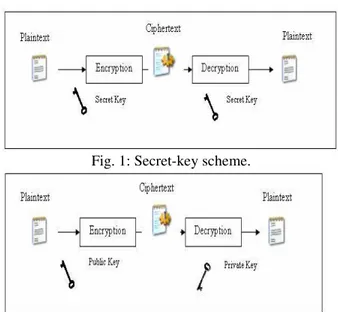
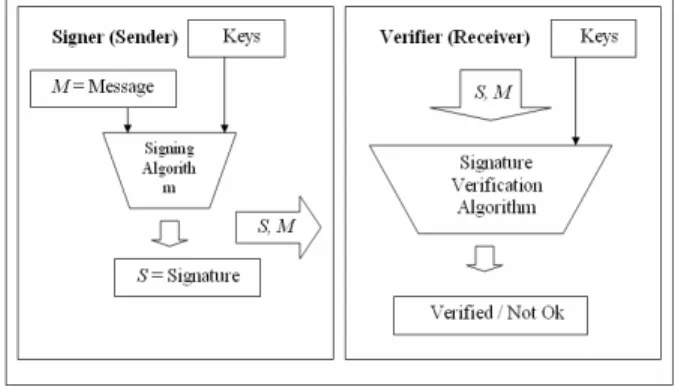
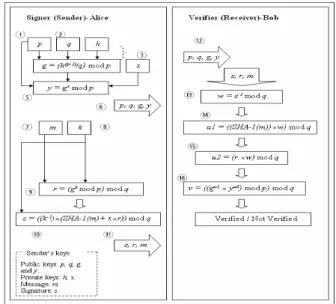
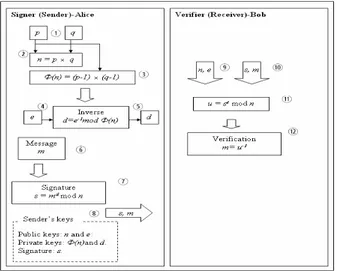
![Fig. 9: Mandelfn image with the sine function (sin( )) [19] .](https://thumb-eu.123doks.com/thumbv2/123dok_br/18157908.328412/5.918.122.432.682.1030/fig-mandelfn-image-sine-function-sin.webp)
![Table 2: Key space comparison between symmetric, RSA and DSA schemes [23] .](https://thumb-eu.123doks.com/thumbv2/123dok_br/18157908.328412/7.918.472.810.373.997/table-key-space-comparison-symmetric-rsa-dsa-schemes.webp)
